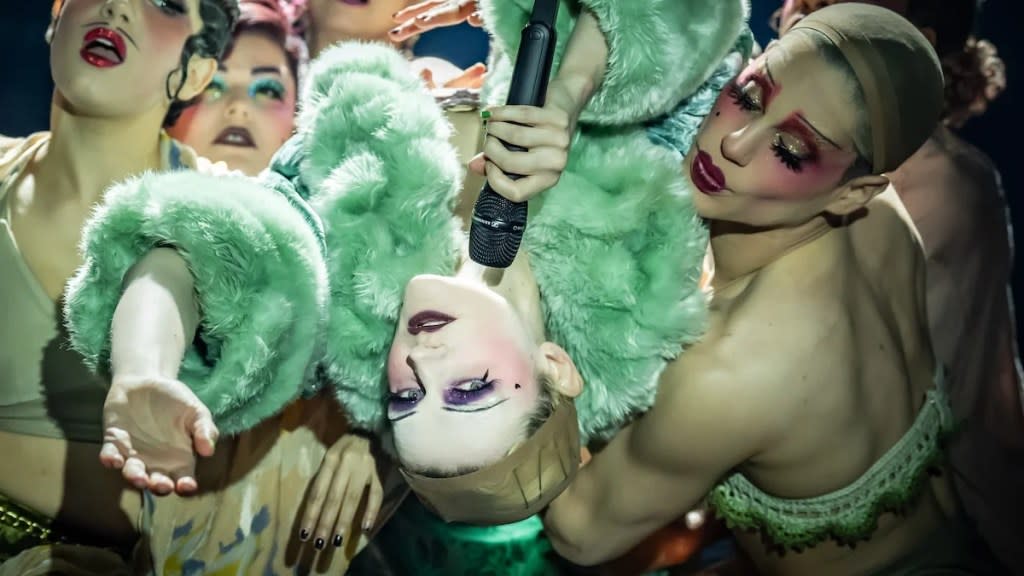‘Cabaret’ Broadway Review: Eddie Redmayne Twists the Emcee Into a Rancid Pretzel

And the Tony Award for Best Makeover of a Broadway Theater goes to… Tom Scutt, who has not only redesigned the August Wilson Theatre — now nicknamed the Kit Kat Club — but the set and costumes for the new “Cabaret” revival that opened there Sunday after a run on the West End.
You now enter the August Wilson Theatre not through the front doors but a side alley, then up a flight of steps that leads to an intimate speakeasy arrangement of tables in cubicles. Seated near the stage, which is now in-the-round, I could not visualize in my mind how this theater used to look. During intermission, I took a tour of the place — only then could I figure out that the balcony is in its original position and that a second mirror-image balcony has been built over what used to be the stage.
Rebecca Frecknall’s direction makes immediate and spectacular use of Scutt’s round stage, which quickly takes on the shape of a tiered wedding cake. Its multiple levels not only revolve, but the center opens to deliver thrilling entrances and exits for the Emcee (Eddie Redmayne), Sally Bowles (Gayle Rankin) and other denizens of the Kit Kat Club.
At first glance, Frecknall’s “Cabaret” looks quite different from Sam Mendes’ version that became a recurring staple at Studio 54 over the years. Beyond the redesigned stage and theater, there are Scutt’s costumes, which eschew the aged tackiness of the Mendes show.
Scutt’s costumes for the Emcee and the Kit Kat Club dancers are so colorfully glitzy that it looks like everybody has escaped from the Olympia doll scene in “The Tales of Hoffman.” Sally Bowles complains that the club isn’t paying her enough, and from the appearance of the chorus, all the money is going for costumes. So much for the Kit Kat being a third-rate nightclub.
Has there ever been a musical that, over the years, has evolved more than “Cabaret”? “Candide” and “Merrily We Roll Along” don’t even come close. The show’s gay content was barely suggested in the original 1966 production on Broadway (book by Joe Masteroff, score by John Kander and Fred Ebb).
Jay Presson Allen’s screenplay for the 1972 movie made explicit that Sally Bowles’ boyfriend (Michael York) is gay or bisexual; Bob Fosse’s direction, on the other hand, was careful to keep any kind of man-on-man activity off-screen. Mendes brought that sexual orientation on stage with a few kisses between the guys.
And now in Frecknall’s version, the Kit Kat Club is essentially a gay bar where anything goes. It’s not a novel idea. Twenty years ago I saw a college production at Loyola University in Los Angeles that offered up a similar same-sex take on the material.
It didn’t work at Loyola and it doesn’t work now on Broadway. Once upon a time, gay bars were a place of refuge. The inhabitants of the Kit Kat Club in “Cabaret” are not taking refuge from the outside world and its homophobia. They are oblivious to the outside world and its raging Nazism.
Frecknell pushes the concept that this den of iniquity is somehow responsible for the rise of Nazism. When Redmayne’s Emcee dresses up in a Stormtrooper Halloween costume, when he (and not some callow youth) sings the Nazi anthem “Tomorrow Belongs to Me,” when the musical’s gay subtext is placed front and center, it gives the impression that someone (the Nazis?) needs to come in to clean up this big mess. It’s also the first “Cabaret” I’ve seen where Sally Bowles actually cures her boyfriend of his homosexuality.
Equally etrange, Frecknell has cast Sally as the Emcee’s alter ego, or vice versa. Sally and the Emcee often dress alike, rip off wigs and sport their skull caps — and, most significant, Redmayne and Rankin have been directed to be abrasive to the extreme. Rankin is able to leaven some of this harshness because Sally is a real character. She convinces us that she’s simply out of control, afflicted with a severe bipolar disorder. Because Redmayne isn’t playing a character but rather a symbol of decadence, he presents nothing but a jumble of mannerisms.
Ato Blankson-Wood plays Sally’s boyfriend Clifford, the nice gay guy who should emerge as the voice of reason. Clifford is Christopher Isherwood, who wrote the show’s original source material, “The Berlin Stories.” Clifford is the show’s moral compass. Blankson-Wood doesn’t have to replicate Rankin or Redmayne’s excesses, but there he is at the end of “Cabaret” crying, screaming and tearing up what’s left of the stage that his costars have already atomized.
Near the end of “Cabaret,” Rankin sings the title song, and like so much of this production, she only plays the subtext — that life is anything but beautiful, despite what the Emcee has been telling us. Indeed, life can be hell. She’s a little late to that realization. Redmayne is the Devil, complete with red hair, from the moment he steps on stage.
The post ‘Cabaret’ Broadway Review: Eddie Redmayne Twists the Emcee Into a Rancid Pretzel appeared first on TheWrap.

 Yahoo News
Yahoo News 
